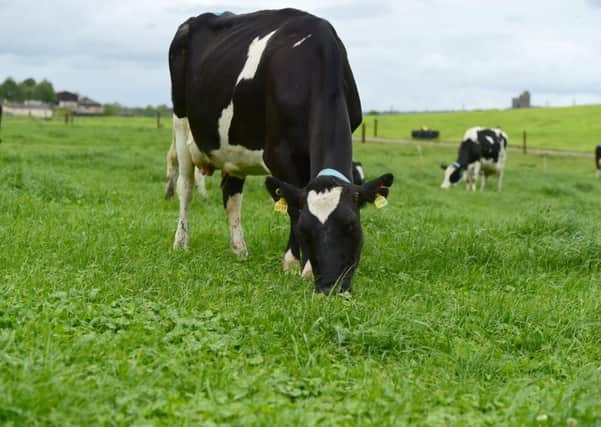Sustainable swards for a sustainable future


However, as farmers are producers of internationally traded commodities, they are ‘price-takers’, and with little opportunity for gaining a significant premium for their produce they can only optimise efficiencies ‘inside the farm gate’.
So what does this mean for the modern day dairy farmer and can economic and environmental sustainability go hand in hand at farm level?
Advertisement
Advertisement
Greater use of white clover is one possible route to gaining a more sustainable credential for milk production and this current PhD study, which is part of the AFBI-Teagasc-QUB PhD program focusing on improving grassland production in Ireland, has already provided some very positive results. The objective was to measure the benefits, if any, of clover inclusion on milk and grass production over two growing seasons. Three 7.3 ha model farms (farmlets) were set up within the Moorepark dairy research farm and each stocked with twenty cows (2.73 cows/ha). All cows received the same concentrate input of 243kg/cow/year, fed mainly in the spring and autumn and each farmlet was required to sustain itself and fulfil its winter feed requirement by making sufficient silage.


Farmlet 1 - grass only swards receiving 250 kg N/ha/year
Farmlet 2 - grass + clover swards receiving 250 kg N/ha/year
Farmlet 3 - grass + clover sward receiving 150 kg N/ha/year
The average yield over the three farmlets was 14 tonnes dry matter/hectare, with an average clover content of 24% for the low N farmlet 3 and 20% for the high N farmlet 2. Both these farmlets had increased production over the grass only farmlet. As can be seen from the table, the cows grazing the grass/clover sward at 250 kg N had the highest milk production at 538 kg milk solids per cow per year. The clover sward receiving 150 kg N was next in line at 523 kg milk solids/cow/year, with the lowest milk production from the cows grazing the grass only sward at 250 kg N. The difference between the cows grazing grass only swards and those grazing the grass clover swards at the same nitrogen level was 35 kg/cow MS or 95.5 kg/ha. Taking a milk price of €4/kg MS, the extra revenue generated would be a substantial €140/cow or €382/ha. Similarly, the cows grazing the lower 150 kg N farmlet had increased milk output of 21 kg/cow MS giving an additional revenue of over €84/cow or €229/ha. Part of this improved output was due to increased sward digestibility, especially in the autumn when the quality of grass begins to deteriorate.
Optimising the use of clover does require some management adjustments. For example, the reduced over-winter and spring growth of grass/clover swards can mean reduced grass availability in spring and a need for extra silage to be fed. An average of 106 kg DM/cow of extra silage was fed to the cows grazing clover swards each spring, though this was produced from the same farmlet swards in the previous growing season. Bloat can also be a cause of concern for farmers, however, strategies such as adding oil to the water supply and not allowing cows to enter a clover sward when they are very hungry has helped to all but eliminate the risk of bloat.
Advertisement
Advertisement
This study has shown the ability of clover to convert significant quantities of atmospheric N into plant usable nitrogen, even on an intensively managed system. As identified in the articles over the past two weeks. Clearly there is opportunity to use white clover to increase on-farm milk production from the same land area. Alternatively it is possible to reduce nitrogen use, increase the sustainability credentials of the farm and maintain the same or better levels of production. This PhD study has added to the existing evidence that greater use of white clover offers the potential to significantly improve both the environmental and economic sustainability of grass based production systems in Ireland.